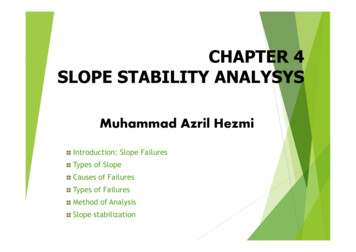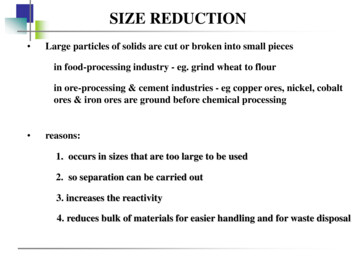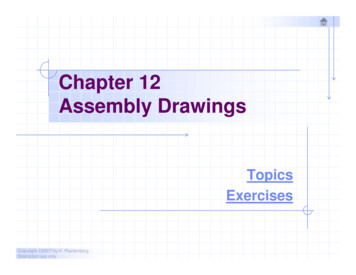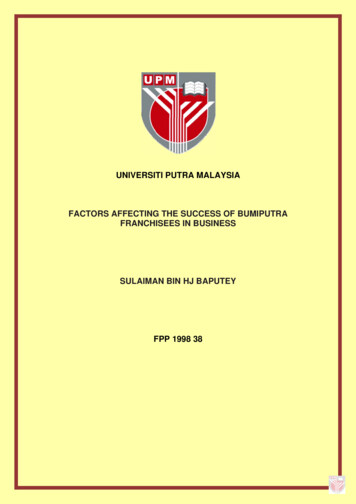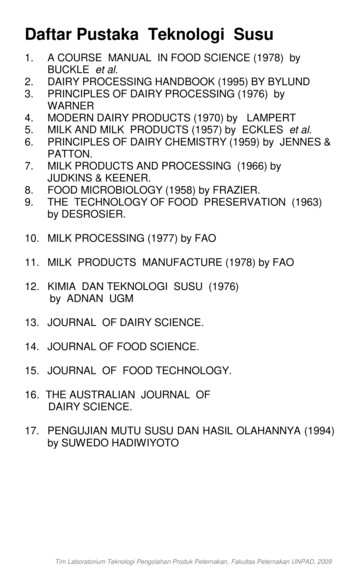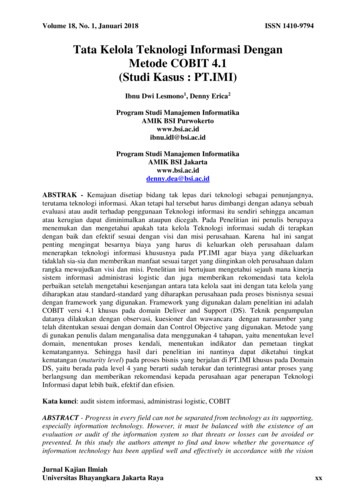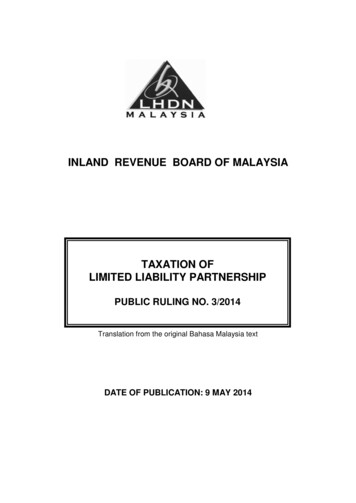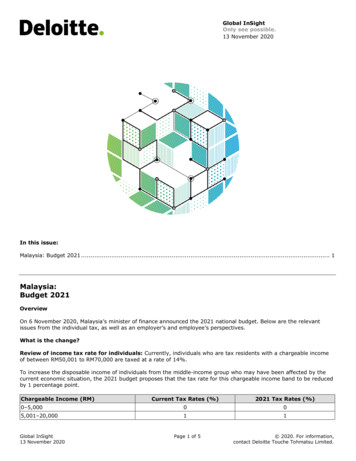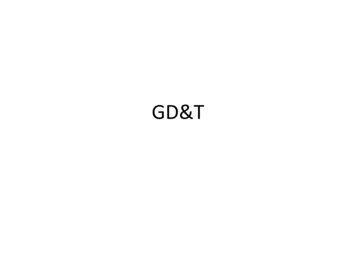
Transcription
GD&T
What is GD&T ASME Y14.5M-1994 -The national standard for dimensioning andtolerancing in theUnited States. ASME stands for American Societyof Mechanical Engineers. The Y14.5 is the standard number. "M" is to indicate the standard is metric, and1994 is the date the standard was officiallyapproved.
What is GD&T Geometric Dimensioning and tolerancing(GD&T) isa language used on mechanicalengineering drawings composed of symbolsthat are used to efficiently and accuratelycommunicate geometry requirementsfor associated features on component andassemblies. A method to specify the shape of a pieceof hardware on an engineering drawing.
A set of fourteen symbols used in the language ofGD&T. It consists of well-defined of symbols,rules, definitions and conventions, used onengineering drawings to accurately describe apart. GD&T is a precise mathematical language thatcan be used to describe the size, form,orientation, and location of part features. GD&T is also a design philosophy on how todesign and dimension parts
Example of part with no GD&T
Example part with GD&T
Compare!
Manufactured parts
Advantages of GD&T Use of this language or tool “can provideeconomic and technical advantage” stated theASME. Maximizes quality of the products. Provides uniformity of specification andinterpretation(reducing guesswork andcontroversy)
Geometric dimensioningdramatically reduces theneed for drawing notes todescribe complex geometryrequirements on acomponent or assembly bythe use of standardsymbology
Advantages of GD&T Ensures the design requirements are carried out. GD&T facilitates an efficient means tocommunicate specific datums on a part. Withoutthe use of a datum system (zero reference) on apart, it is not clear to manufacturing or qualitywhere to manufacture or measure from.Additionally, the use of datums dramaticallysimplifies the design and specification of parts foruse in manufacturing and quality verificationsteps.
Advantages of GD&T Create a part design that focuses on the product function. Convert product requirements into dimensionalspecifications. Better define parts without the need for assumptions. Document the design for future use. Discover problems in the design stage Ensure that parts will assemble. Have less "hand fitting" at assembly. Ensure that parts are inspected as intended. Inspect parts more quickly. Reduce scrap or rework. Make a replacement that fits into the assembly
Advantages of GD&T Have multiple sources on various parts of an assembly.Make valid engineering calculations.Have common parts across similar assemblies.Design subassemblies in different locations andhave themfunction correctly.Do tolerance analysis to study the effect of parttoleranceson the assembly.Use state of the art software tools to analyze parts inanassembly.Use state of the art software tools to inspect the parts.Reduce the risk caused by vague specifications.saves money
Geometric Tolerances are divided intofive categories 1.Form control2.Orientation control3.Location control4.Composite control5.Profile controls
Form control
Orientation control
Location control
Composite control
Profile control
Summary of control tolerances Orientation is refinement of location. Form is refinement of orientation
Geometric Dimensioning &Tolerancing symbols
modifiers
Feature control symbols with datum references
Datum
datum
Datum vs datum feature
Datum feature symbol When the datum is the axis or center plane
Datum feature symbol
datum targets The datum targets are indicatedby a circular frame divided in twocompartments by a horizontalline. The lower compartment isreserved for a letter and a digit. The letter represents the datumfeature and the digit datumtarget number. The upper compartment isreserved for additionalinformation, such as dimensionsof the target area.
Datum target A specified point, line or area on a part usedto establish a datum.
Common datum A common datum is a type of Datumthat corresponds to a datumt hat isestablished from more than one datumfeature. On technical drawing, a datum that isestablished from multiple datumfeatures is indicated by by placing theidentifying letters of the datum features,separated by a dash, within a singlecompartment in a feature control frame. There is no significance to the order ofthe datum feature identifying letterswithin a compartment of the featurecontrol frame
Datum system A group of two or more separate datumsusedas a combined reference for atolerancedfeature.Datum reference frameDatum reference frames are coordinate systems used tolocate and orient part features.
Datum reference frame A framework that consists of three mutuallyperpendicular datum planes, three datum axes(locatedat the intersection of each pair of datum planes), and adatum point (that is located at the intersection of thethree datum planes). A Cartesian coordinate system established using theDatums extracted from a set of Datum Featuresreferenced in a Feature Control Frame. DatumReference Frames serve to orient and locate tolerancezones.
Datum reference frame
Material conditions Features of size which includes datum features have size tolerances The size condition or material (amount of metal) condition can vary frommaximum metal condition (MMC) to the least metal condition (LMC) If the center planes or axes of a feature of size are controlled by geometrictolerances a modifying symbol can be specified in the feature controlframe, that applies the tolerance value either MMC or LMC Can also use for a datum that a feature of size If a symbol is not specified – regardless of material condition, use RFS(regardless of feature size)
Regardless of Feature Size (RFS): It is applicable if theMMC or the LMC are not specified forindividual features of size tolerances or for datum featuresof size. The tolerance is limited to the specified value in the FCF and ifapplied to a datum feature of size the actual axis or center planehave to be established regardless of the feature size. It is always used for run out, concentricity, and symmetry controls It is also used when targets are specified to establish datum axesand center plane sbecause the targets have to contact the datumfeatures to be useful. Also it is used to control wall thickness variation between externaland internal features. Hard gages are not applicable since there isno additional or bonus tolerance as allowed for MMC and LMC.
Example: RFS
Maximum Material Condition (MMC) The condition in which a feature of sizecontains the maximum amount of materialevery where within the stated limits of size
Maximum Material Condition (MMC)
MMC vs LMC
Least Material Condition (MMC) The condition in which a feature of sizecontains the least amount of materialeverywhere within the stated limits of size
Maximum Material Condition (MMC) This is the condition when the actual mating size or envelope size isat the maximum material condition which is maximum size for anexternal feature such as a cylinder and the minimum size for aninternal feature such as a hole. The symbol is “M” The added tolerance is the difference between the actual matingenvelope size and the MMC size. the largest actual mating envelope named virtual condition is equalto the MMC size plus the tolerance specified in the FCF for anexternal feature and minus for an internal feature. The MMC symbol is used to assure that parts will assemble and itallows the use of so called hard gages (go gages) for quickinspections. The actual local size has to meet the size tolerance however theactual local size does not affect the geometric characteristictolerance
Maximum metal condition
Least Material Condition (LMC) This is the opposite of MMC this is the condition when the actual minimum mating size orenvelope is at the minimum material condition which is minimumsize for an external feature such as a cylinder and the maximum sizefor an internal feature such as a hole. The symbol is “L” the smallest actual mating size is equal to the LMC size minus thetolerance specified in the FCF for an external feature and plus for aninternal feature. The LMC symbol is used to assure a minimum amount of machiningstock for features that are to be machined and for assuring aminimum amount of wall thickness between external and internalfeatures. Hard gages cannot be used for inspection the actual local size has to meet the size tolerance however thelocal size does not affect the geometric characteristic tolerance
Least metal condition
Maximum and minimum materialcondition – two hole patterns
True-position dimensioning
roundness
cylindricity
Concentricity Concentricity describes a condition in whichtwo or more features (cylinders, cones,spheres, etc.) In any combination have acommon axis.
concetricity
Straightness
Angular
Flatness
Flatness All surface elements of the tolerance featuremust lie between two parallel planes 0.2apart.
Flatness Applications To ensure the integrity of mating or mountingsurfaces To ensure that surfaces seal properly Appearance
Flatness – flange mounting
Flatness – sealing surface Flatness control to ensure propergasketcompression
Flatness- sealing surface
Angularity
Profile
Profile
concentricity
perpendicularity
Parallelism
Parallelism
Circular runout A dial indicator is often used toverify a runout control First, the part is located in a chuckor collet to establish datum axis A. A dial indicator is placed on thesurface being checked. As the part is rotated 360 degree,the dial indicator movement is therun out value of thecircular element. Several independent dial indicatorreadings are made at differentplaces along the diameter.
Total runout Total run out is used to control the combinedvariations of circularity, straightness,coaxiality, angularity, taper and profile whenapplied to surfaces around and at right anglesto a datum axis. Note that total runout cannot be applied toconical or curved surfaces as can circularrunout.
Run-out
Application of GD&T
Surface texture symbols
Application of surface texture symbol
Lay symbols
GD&T facilitates an efficient means to communicate specific datums on a part. Without the use of a datum system (zero reference) on a part, it is not clear to manufacturing or quality where to manufacture or measure from. Additionally, the use of datums dramatically simplifies the design and specification of parts for use in manufacturing and quality verification steps. Advantages of GD&T File Size: 2MBPage Count: 80
